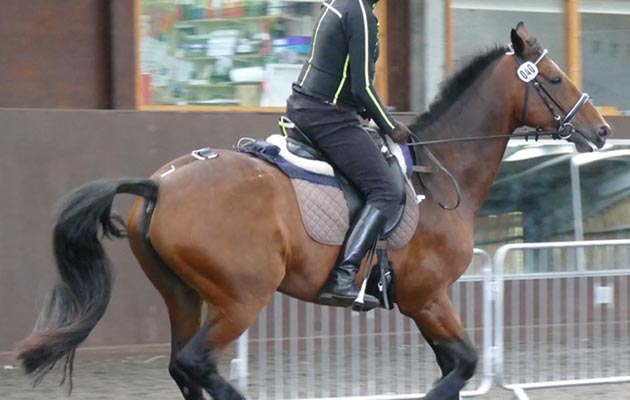Applying traction to a horse’s tail is a widely-used therapy believed to help relieve back pain, but does recent research support its efficacy? Dr Peter Green explains...
EQUINE physical therapies vary: some are similar to human medical physiotherapy, while others are more akin to human alternative therapies. Whichever school of therapy the practitioner uses, traction is a common tool.
The tail pull is a widely used traction therapy, where the practitioner pulls steadily backwards on the tail for a short time and then repeats the procedure. It is claimed to relieve back pain.
Researchers used a group of 32 horses referred to a veterinary hospital in New Zealand for apparent back pain to assess the efficacy of the technique.
{"content":"PHA+VGhlaXIgZmluZGluZ3MsIHJlY2VudGx5IHB1Ymxpc2hlZCBpbiB0aGUgPGVtPkpvdXJuYWwgb2YgRXF1aW5lIFZldGVyaW5hcnkgU2NpZW5jZTwvZW0+LCBzdWdnZXN0IHRoYXQgdGhlIGNsYWltIG1heSBiZSBqdXN0aWZpZWQuIDwvcD4KPHA+UmVzZWFyY2hlcnMgIGFzc2Vzc2VkIHRoZSBob3JzZXMgZm9yIHRlbmRlcm5lc3MgaW4gdGhlIGJhY2sgbXVzY2xlcyB1c2luZyBhbiBhbGdvbWV0ZXIuIFRoaXMgbWVkaWNhbCBpbnN0cnVtZW50IGluY3JlYXNlcyBwcmVzc3VyZSBwb2ludCBzdGltdWxhdGlvbiBvZiBzb2Z0IHRpc3N1ZXMsIHRvIG1lYXN1cmUgdGhlIHRocmVzaG9sZCBhdCB3aGljaCB0aGUgcHJlc3N1cmUgYmVjb21lcyB1bnBsZWFzYW50LjwvcD4KPHA+PGRpdiBjbGFzcz0iYWQtY29udGFpbmVyIGFkLWNvbnRhaW5lci0tbW9iaWxlIj48ZGl2IGlkPSJwb3N0LWlubGluZS0yIiBjbGFzcz0iaXBjLWFkdmVydCI+PC9kaXY+PC9kaXY+PHNlY3Rpb24gaWQ9ImVtYmVkX2NvZGUtMzEiIGNsYXNzPSJoaWRkZW4tbWQgaGlkZGVuLWxnIHMtY29udGFpbmVyIHN0aWNreS1hbmNob3IgaGlkZS13aWRnZXQtdGl0bGUgd2lkZ2V0X2VtYmVkX2NvZGUgcHJlbWl1bV9pbmxpbmVfMiI+PHNlY3Rpb24gY2xhc3M9InMtY29udGFpbmVyIGxpc3RpbmctLXNpbmdsZSBsaXN0aW5nLS1zaW5nbGUtc2hhcmV0aHJvdWdoIGltYWdlLWFzcGVjdC1sYW5kc2NhcGUgZGVmYXVsdCBzaGFyZXRocm91Z2gtYWQgc2hhcmV0aHJvdWdoLWFkLWhpZGRlbiI+DQogIDxkaXYgY2xhc3M9InMtY29udGFpbmVyX19pbm5lciI+DQogICAgPHVsPg0KICAgICAgPGxpIGlkPSJuYXRpdmUtY29udGVudC1tb2JpbGUiIGNsYXNzPSJsaXN0aW5nLWl0ZW0iPg0KICAgICAgPC9saT4NCiAgICA8L3VsPg0KICA8L2Rpdj4NCjwvc2VjdGlvbj48L3NlY3Rpb24+PC9wPgo8cD5UaGUgcmVzcG9uc2UgdG8gcHJlc3N1cmUgd2FzIG1lYXN1cmVkIGF0IGVpZ2h0IHBvaW50cyBhbG9uZyB0aGUgYmFja3Mgb2YgdGhlIGhvcnNlcywgZWl0aGVyIHNpZGUgb2YgdGhlIHNwaW5lLCBmcm9tIHRoZSBiYWNrIG9mIHRoZSByaWIgY2FnZSB0byB0aGUgcGVsdmlzLiBBIHNtYWxsIGRpZ2l0YWwgd2VpZ2hpbmcgc2NhbGUgd2FzIHRoZW4gaG9va2VkIGludG8gdGhlIHBsYWl0ZWQgdGFpbCBvZiBlYWNoIGhvcnNlLiBBIHN0ZWFkeSBwdWxsIG9mIDQuNWtnIHdhcyBhcHBsaWVkIGZvciAyMCBzZWNvbmRzLCBmb2xsb3dlZCBieSBhIDEwIHNlY29uZCByZXN0LCB0aGVuIHJlcGVhdGVkIHR3aWNlIG1vcmUuIFRoZSBhbGdvbWV0ZXIgbWVhc3VyZW1lbnRzIHdlcmUgdGFrZW4gb25jZSBhZ2Fpbi48L3A+CjxkaXYgY2xhc3M9ImluamVjdGlvbiI+PC9kaXY+CjxwPkFmdGVyIHRoZSB0YWlsIHB1bGwgdGhlcmFweSwgdGhlIGJhY2sgbXVzY2xlcyB3ZXJlIG11Y2ggbGVzcyB0ZW5kZXIuIFRoZXJlIGNvdWxkIGJlIHNldmVyYWwgZXhwbGFuYXRpb25zIGZvciB0aGlzIGVmZmVjdCwgYnV0IHdlIGtub3cgdGhhdCB0aGVyZSBhcmUgc3RydWN0dXJhbCBsaW5rcyBiZXR3ZWVuIHRoZSB0YWlsIGFuZCBvdGhlciByZWdpb25zIG9mIHRoZSBiYWNrLiA8L3A+CjxwPk1vcmUgcmVzZWFyY2ggaXMgdW5kZXIgd2F5LjwvcD4K"}
Further reading : Journal of Equine Veterinary Science 93: tail pull traction
H&H 29 October 2020
You may also be interested in…
Back pain in horses can cause problems with temperament as well as performance
Credit: Dr Sue Dyson
Heavier riders and unsuitable saddles can cause muscle tension and pain in horses according to a study by Dr Sue
Our chartered physiotherapist investigates back pain in horses and how to recognise if your horse is suffering from it
Do we always listen to what our horses are trying to tell us? A new study is linking facial expressions




